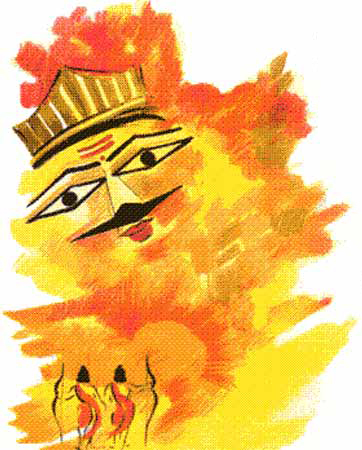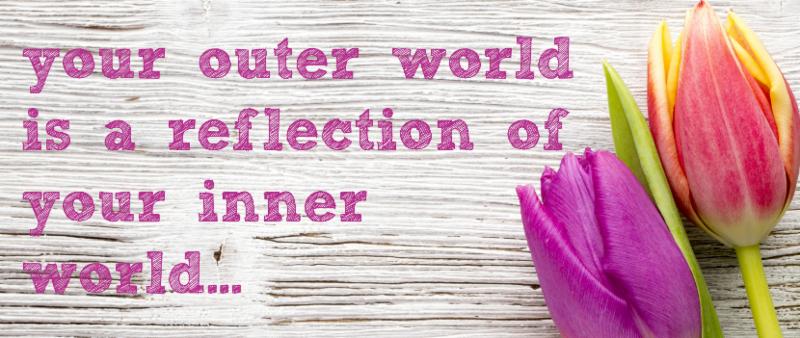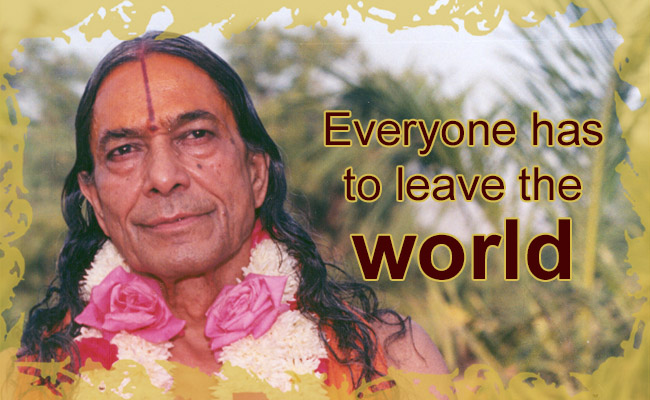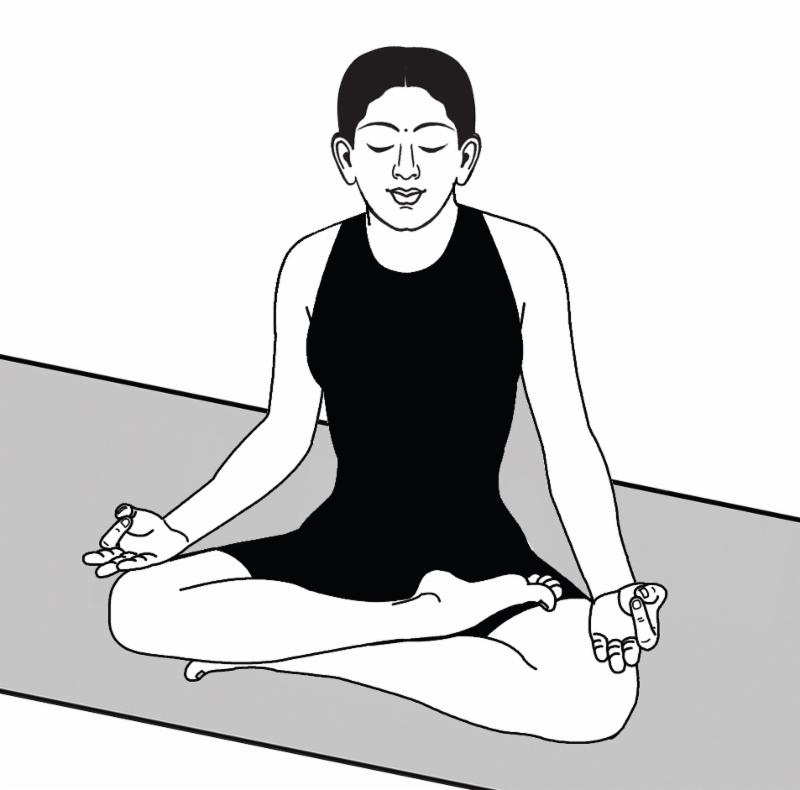|
|
JKYog
e-Magazine, Issue No. 73
|
|
|
 Editor's Message
Dear Readers,
JKYog
is delighted to bring you our Dusshera edition, where our theme is 'The
Two Kinds of Worlds.' In the first article, we explore the two
kinds of worlds - the inner world and the external world. Our
second article is, 'The external world is perfect.' Further, from
Maharajji's lecture, we will understand that whether it is a sage, an
ascetic, a yogi, a Saint, or even God, everyone has to leave the world
at the appointed time. Also, we will share with you news updates
and glimpses of recently concluded Swamiji's USA Tour, 2015.
To help relieve your headache, we introduce you to some asans and
pranayam. Finally, don't miss our BM contributions, and bhog recipe.
Best Wishes,
Editor's Desk
editor@jkyog.org
|
|
|
|
झूठा जग नाता सपना, साँचो नाता हरि से मना |
jhooṭhā jaga nātā sapanā,
sāṅcho nātā hari se manā
All worldly relationships are false, as in a dream. O mind! Your only true relationship is with Shyamsundar.
|
|
|
jai rāghavendra sarakāra kī, jai sītā sukumāra kī
All glories to the Supreme Lord Ram, and to the gentle princess Sita.
jai rāma lakṣhmaṇa jānakī,
jai sudhā roopa rasa khāna kī
All glories to Ram, Lakshman, and Janaki, the treasure-house of infinite nectar, beauty and bliss.
jai jai jai rajā rāma kī,
jai prema roopa rasa khāna kī
All glories to our king Ram, the infinite reservoir of love, beauty and bliss.
jai rāghavendra darabāra kī,
jai jai jai pavana kumāra kī
All glories to the court of Shree Ram (where grace is distributed freely), and to Pavan Kumar (Hanuman).
|
The Two Kinds of Worlds
 There
are two kinds of worlds - the inner world and the external world. The
external world as we all know is made of earth, water, fire, air, and
space; it is the combination of these five gross elements and the other
subtle elements. However, there is an internal world as
well. Sigmund Freud, the father of modern psychology, had
introduced the concept of subconscious. Interestingly, this concept is
already found in Vedic literature and is there since thousands of years.
The Maitreyyupanishat says that there is a world inside us. chitmeva hi sansārastatprayatnena śhoghayet
The
inner world within us is exceedingly big. It is so big that even
the external world that we see, is nothing in comparison to it. We
come in contact with our internal world when we are asleep.
Recall how in the dream state we hear, touch, see and smell
things. How do we manage to do these things when our knowledge and
working senses are under the comforter? The eyes are closed while
sleeping which means we are obviously not seeing the external
world. There is a world other than the world that we see when we
are awake. This other world is our inner world and it is
extraordinarily fascinating. In the inner world, we sometimes go
all the way to Hong Kong, Singapore, to the moon, we meet God or we even
meet demons. You may find it interesting that even somebody who
is blind from birth can see dreams. So how does a blind person
see dreams? What people with sight see in their dreams are the
things they have seen or thought during the waking state. When
they sleep, those thoughts or resolves are disjointed and rejoined in a
jumbled manner and that becomes the dream. For example, a
person sees a bird flying and he thinks what a thrilling experience it
would be to become a bird and fly. He sees the bird and
makes the resolve. Now in the dream state, possibly these
two resolves will be joined. So, he may not become a bird but he will
start flying in his human state and that becomes his dream. Now,
why does that happen? In the dream state, the intellect is
sleeping but the mind is still active. That is the sleep state.
Throughout the day the body tires, but that is not enough to fall
asleep. It is when the intellect is tired, that one falls
asleep. When we sleep, the intellect falls asleep but the mind
remains awake. Therefore, all these thoughts that exist in the
inner world start joining without rationality. Hence, an
intelligent person doesn't give much importance to dreams. One in a
million maybe a divine dream inspired by God, but the other 9,99,999
are merely the creations of an irrational mind. Now people with
sight dream in accordance with what they have seen in the waking state,
but how does a person who is blind from birth see dreams? They
see dreams because the inner world of a human continues from past lives.
We all know that when a person dies, his or her soul leaves the body
and the gross body is left behind. However, the soul does not
leave alone; it is accompanied by the subtle body consisting of the
mind, intellect, and ego. Therefore, our mind is not from just one
lifetime, it contains impressions from countless past lifetimes and
these impressions form the basis of dreams for people who are blind from
birth. That is the inner world. Simply put, the external
world is one for everyone. If there is the hall of Durga Mandir, it is
the same for all the people. But the internal world is different
for everyone. One person associates the temple with peace, one
person associates it with devotion, one with faith and a young teenager
who is forced there by his parents associates it with a torcher chamber
that is terribly boring. So, our inner world is our own creation
and the external world is not our creation, it is the creation of God.
|
 |
The External world is perfect
Brilliance
of God manifests in the world all around us. Tiniest of atoms to
the largest of galaxies, each creation of God is a reflection of the
perfection with which He has created this world. In fact, the
Vedas say that the world is a veritable form of God. They even go on to
state that God himself becomes the world. Just as a spider takes
the web out from itself-it does not make the web with any external
material-similarly God does not use any external material for the
creation of the world; he becomes the world himself through his
energies. So, there is no question of God's creation being flawed;
the world is perfect. 
However,
when we see the world stricken with wars, natural calamities, and so
much chaos, we wonder "is it true that the world is perfect? If so
what really is that perfection?" The answer is that God has
created this world perfectly for the evolution of our soul. The
soul is on a journey and this journey did not begin upon birth, nor is
it going to end upon death. It's a journey that is continuing from
infinite lifetimes. We are all in this journey - evolving,
learning, and developing. The difficulties and hardships existing
here are also a part of the perfection. They are perfectly placed
there for a purpose.
Now if
the world is perfect, why do we experience such imperfect
experiences? Living in this world, why do we constantly
experience tension, fear, anxiety, and stress? The reason for such
experiences in this perfect world of God is our own mind or what we
call the inner world. Our experience of the external world is
filtered through the perceptions of our mind. Hence, it is the
mind that creates perceptions of anxiety, fear, stress, and every other
kind of human emotion.
When
we experience distress we immediately look for defects in the external
world. Our intellect tells our problems are in the external world,
but the Vedas tell the problem is in our own mind. Our first and
foremost focus should always be to correct our own mind; to cleanse and
purify our inner world. Those souls who purified their mind
experience the bliss of God in every atom of his creation. Hence,
Lord Shiv told Parvati: "Uma if a fortunate soul is able to finish
blemishes of desire, anger, and pride, that fortunate soul sees the form
of God in every atom of creation."
The wise sages who have purified their inner worlds through the process of bhakti
see the external world as a veritable form of God and hence experience
infinite bliss. In fact, everlasting peace can become a
practical reality for anyone who engages in bhakti to
God. By attaching the mind to all-pure God, the mind gradually
becomes purified and experiences its much-cherished ideal of peace and
bliss.
|
 |
Everyone has to Leave the World
 Whether
it is a sage, an ascetic, a yogi, a Saint or even God, everyone has to
leave the world at the appointed time. The world may say that
so-and-so died of heart attack, or cancer, but the fact is that his time
to die had arrived. Even God does not stay a moment longer than
the scheduled period of His descension. Then how can anyone else
stay beyond his appointed time? You may have heard of an incident
in Ayodhya in this context. Yamraj came to Lord Ram to tell Him
that the period of His descension was over. When Yamraj comes to
God and the Saints, he places his head at their feet and says, "I have
come to inform you that the period of Your descension is complete.
You may choose to stay or leave. I am merely fulfilling my
duty." He cannot force them to leave as he does with others.
Yet, the supremely independent Ram did not stay a moment longer than
His planned 11,000 years. At the exact time, to the second, He
left the world. And this is true for every descension of God, and
every Saint, whether it be Tulsidas, Surdas, Meera,orKabir. Seeing
that even God, who is the lawmaker Himself, does not violate this rule,
then why should the Saints, who are His servants break the law? When
we say we do not wish to die, it can be for two possible reasons.
One reason is that we are too attached to the world-to wealth, home,
father, mother, wife, son-and still wish to enjoy them, and so do not
wish to leave. On the other hand, elevated aspirants have a
sensible reason for not wanting to die. They think, "I have not
attained God as yet. If I had some more time, I could achieve my
goal." They want more time, just like students who become very
happy when given a few extra days to study for exams. But, God and
Saints have nothing to attain. They leave at the appropriate
time, without any reluctance. There is an incident about
Ramakrishna Paramhans. He developed throat cancer. Everyone
knew that the Saint's death was imminent. He was famous in Kolkata
and all over Bengal as a Saint who had transformed many lives.
So, people went to him and said, "You have attained perfection. To
rid yourself of cancer is child's play for you. Just ask God to
cure you, and your cancer will disappear." Ramakrishna Paramhans
replied strictly, "Should I divert my mind from God to worrying about
cancer? Besides, how can I ask God to do such dirty work for
me? I have loved God only with the desire to serve Him. I
cannot engage in such pettiness and ask for His help just for the sake
of this wretched body. Moreover, even if I am cured, I will still
have to leave my body at the appointed time." So, Ramakrishna
Paramhans said, "Everyone has to leave at the scheduled time. I
have no objection to this hole in my throat. This body has nine
holes anyway-the eyes, nose, ears, mouth, etc. So what if there is
one more! It would be very wrong to bother the Divine Mother over
it." Thus, asking God for worldly favours is the greatest folly.
|
|
|
Swamiji's
humanitarian work in the service of the people around the world was
commended by the Mayor of Oak Brook, IL, in his proclamation. He
presented Swamiji with a key to the village.
JKYog
New York organized a gala Diwali Dinner in the divine presence of
Swamiji. The highlights of the evening included haunting devotional
songs by the Angels Caribbean Band, Karnatic Dance performance, a divine
message from Swamiji, and mouthwatering Caribbean and Indian cuisine.
The proceeds from the program will support health care and education for
the underprivileged in rural India. See pictures
Swamiji
began his revisit tour of all the JKYog centers in US with one or two
day program in every city. The devotees were delighted to have him
back in their midst before he leaves for India in October end. See pictures
|
|
|
 |
Swamiji's India Tour, 2015
|
|
Oct 22nd to 24th
|
Delhi
| |
Nov 5th to 8th
|
Dallas
| |
Nov 15th to 20th
|
Banara, Cuttack, Odisha
| |
Nov 27th to Dec 1st
|
Vrindavan Dham
|
|
|
Oct 25th to Nov 3rd
|
Bhakti Dham, Mangarh
| |
Nov 10th to 14th
|
Delhi
| |
Nov 21st to 26th
|
Bhakti Dham, Mangarh
| |
Dec 4th to Dec 21st
|
Banara, Cuttack, Odisha
|
|
| |
For details, click here
|
|
Yoga to Help Relieve Headache
|
|
|
|
Whether
from dehydration, stress, tension, a hangover, or anything else,
headaches can really put a dampener on anyone's day. With the ability to
help relieve tension, boost circulation, and calm the mind, yoga can be
a powerful natural remedy for headaches. If you're feeling a headache
coming on -- or just need a little stress relief -- try these yoga poses
and pranayama.
Procedure:Lie
flat on your back with both your legs together and touch the outer
sides of the thighs with your palms Place both arms by the sides
of the thighs with the palms flat on the floor. While inhaling
(Radhey), raise your legs till they come into a vertical
position. While exhaling (Krishna), slowly raise the buttocks,
letting the legs go over the head, and then lower the toes to the
floor-a bit away from your head. Either interlock the fingers or
keep the palms on the floor, behind your shoulders and facing
downward. Straighten your arms firmly for support; straighten the
legs and try to push the buttocks as much forward as possible.
Remain in this posture for as long as you are comfortable with normal
breathing. While returning to the central position, again inhale
(Radhey); then slowly lower the buttocks to the floor, bringing the
legs to vertical position; while exhaling (Krishna), lower the legs
down to the floor. This finishes one round; do two more
rounds. Finally, come into Shavasan.
Contraindications:
Persons
with high blood pressure, hernia, arthritis of the neck, spinal
problems like cervical spondylitis, and slipped-disc should not do this
asan.
Shashankasan (The Moon Pose)
Procedure:
Sit down with your legs outstretched and joined together in front;
keeping the back erect, place your palms on the floor behind the
buttocks, with the fingers pointing backward, i.e. Dandasan.
Slowly come into Vajrasan and rest your palms on the thighs.
Inhale (Radhey); raise your arms up above the head; straighten the
trunk, head, and arms; turn the palms forward. Now, while exhaling
(Krishna), gently lean forward from the hips until the hands and
forehead reach the floor. Slightly flex your elbows and let them
rest on the floor so that the whole body rests completely. Be in this
posture for as long as possible with slow and even breathing.
Ultimately, come back to the base position.
Contraindication: People with high blood pressure and slipped-disc should not do this asan.
Ujjayi Pranayam

Procedure: Sit in any meditative position with the spine, neck, and head straight. Now, relax your shoulders and place the hands in any mudra
on the knees. Then, close both eyes and relax the entire
body. Concentrate on the nostrils, feel the air going in and
coming out through the nostrils. After 2-3 normal breaths, shift your
concentration to the throat. Then, inhaling (Radhey) deeply and slowly
through either of the two nostrils, contract the throat as if you are
breathing through a narrow pipe (in the throat). Due to the
constriction of the respiratory passage, the incoming breath will
produce a soft sound like "urrmh," as if you are snorting. It may be a
low sound, and though it should be audible to you, someone sitting a few
feet away from you may not be able to hear it. Then close one of the
nostrils with your thumb and exhale (Krishna) completely through the
other. You may use either of the nostrils for exhalation, but
alternatively. The time for inhalation and exhalation should
always be the same. This is one cycle of Ujjayi Pranayam; repeat up to
15-20 cycles.
Contraindications: People
who are introvert should not do this pranayam. Heart patients should
not strain themselves and should practice one round of Jai Radhey
Pranayam between two rounds of Ujjayi Pranayam.
|
|
|
JKYog Presents
Bal-Mukund
Personality Development Classes for Children
| |
|
|
It was a festive month for Bal-Mukunds, loaded with merriments as the
Young Bal-Mukunds celebrated the birthday of Lord Krishna and Lord
Ganesh!! Most of the centers celebrated Janmashtami and Ganesh
Chaturti!!! Bal-Mukunds learned about these festivals, the significance
of it and the way it is celebrated. They also got to practically
celebrate the festival. Few centers made nice Bal-Krishna picture
frames, beautiful clay statues of Bal-Ganesh and celebrated their Happy
Birthday with cake, bright balloons and songs! The kids also got to rock
baby Krishna in the Jhoola!!
Singapore Bal-Mukunds presented a
cultural program to a wide audience on the occasion of Janmashtami, They
recited slokas, danced to Krishna bhajans and enacted beautiful leelas
of Lord Krishna!!!Not to mention the wonderful Janmashtami
celebrations!!!
Kids had a wonderful time at the Texas retreat
conducted in Dallas during Labor day weekend!!! Kids got to make
beautiful crafts, learn bhajans, learn about the distinction between
soul and the body through an interactive game and listen to great
Krishna stories at the retreat. All the kids got an opportunity to
interact with Swamiji and show what they learned during the retreat.
They also got to ask questions and get clarifications from Swamiji. For
the Janmashtami celebration at the retreat, enthusiastic kids exhibited
their talent in the Kids Talent show!!! It was a wonderful event and
both the kids and the older participants thoroughly enjoyed it!!
|
| |
|
|
|
|
 |
|
|
|
|
Ingredients:
- 16-18 dates pitted
- 3/4 milk
- 2-3 tsp brown sugar
- 1 cup all purpose flour(or use whole wheat flour)
- 1/2 cup oil
- 1/2 tsp baking soda
- Walnuts as desired
|
|
Soak 14
chopped dates or so in milk for 3-4 hrs. Then grind to fine paste..Add
oil, brown sugar and the flour. Chop rest of the dates and walnuts and
mix in batter. Mix well.
Bake for 45-50 mins at 350 degrees. Offer as bhog and enjoy!
|
|
Contact us
|
The Editor JKYog: XVII/3305, 1st Floor, Ranjit Nagar
(Near PUSA), New Delhi - 110008, India
|
7405 Stoney Point Dr, Plano
TX 75025, USA
|
|
|
|
|
|